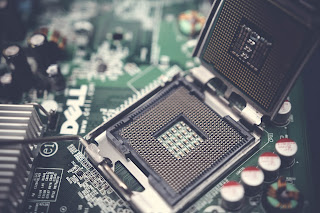100 Amazing Inventions
16. How have microprocessors changed the history of computers?
MICROPROCESSORS:
A microprocessor is an electronic component that is used by a computer to do its work. It is a central processing unit on a single integrated circuit ship, containing millions of very small components including transistors, resistors and diodes that work together.
The microprocessor is one of the most central parts of any computer device. Microprocessors were invented by Tedd Hoff, along with his fellow workers working at a young Silicon Valley start-up called Intel.
They changed the history of computers, for till then, computers had been huge and awkward. The microprocessor allowed computers to shrink in size, but also grow in speed. The microprocessor paved the way for the age of personal computers.
17. What is a touch screen?
TOUCH SCREEN:
The Touch Screen is a type of display screen that has a transparent panel covering the screen. This panel is sensitive to touch. It allows a user to interact directly with what is displayed on the screen, without using a device like a mouse.
Touch screens are designed to respond to the touch of a finger. The idea of a touch screen was first developed by E.A. Johnson at the Royal Radar Establishment in England. His idea was described in a short article published in 1965. However, it is Dr. Sam Hurst who is popularly believed to be its inventor. In 1971, he developed a sensor called the 'Elograph'.
From mall kiosks( information screens ) to smart phones to tablet computers, touch screens are seen everywhere these days.
18. How has C Programming language changed computing?
C Language:
In the late 40s and early 50s, computers programs were entered by flicking switches. It was quickly achieved how inefficient and slow that was and computer programming languages soon appeared.
A Programming language is a special language that computer programmers use to develop software programs, scripts or other sets of instructions for computers to execute. Each and every operation that your computer performs has instructions that someone had to write in a programming language.
C is one such a programming language. That means that you can use C to create lists of instructions for a computer to follow. It is one of thousands of programming languages now in use. C was developed between 1969 and 1973 by Dennis Ritchie at AT&T Bell Laboratories.
Programs written in C language are efficient, fast, and easy to understand. Therefore, it is not surprising that C is among the most successful and popular programming languages.
19. How has the personal computer or PC changed the world?
PERSONAL COMPUTERS:
Today's personal computers are extremely different from the massive, giant machines that emerged after World War II.
But, one of the most significant of the inventions that paved the way for the PC revolution was the microprocessor. Many other innovations followed, which made it cheaper and easier to manufacture computers than ever before.
As a result, the small, relatively cheap 'microcomputer' soon known as the 'personal computer' was born. Soon companies like Xerox, Tandy, Commodore, and IBM had entered the market and computers became common in offices and eventually homes. Today, laptops, smart phones, and tablet computers allow us to have a PC with us wherever we go.
At home and at work, we use our PCs to do almost everything. It is nearly impossible to imagine modern life without them.
20. What is PET?
PET:
PET is not an animal. These three letters stand for Polyethylene terephthalate, strong and lightweight plastic belonging to the polyester family.
It is usually called 'polyester' when used for fibres or fabrics and 'PET' when used for bottles , jars, containers and packaging applications. PET was first synthesized in the U.S. during the mid 1940s by DuPoint chemists in their search for innovative new textile fibres.
In the late 1950s, researchers found a way to stretch a thin sheet of PET to create PET film. In the early 1970s, the technology was developed to mold PET into strong, lightweight and shatterproof bottles. PET does not react with food products, which is why it is widely preferred for packaging food, drinks and pharmaceuticals.
It is recyclable, which means it is friendlier to the environment. Today, PET is one of the world's most commonly used, versatile and trusted materials, both in the textile( fabric ) and food packaging industry.









